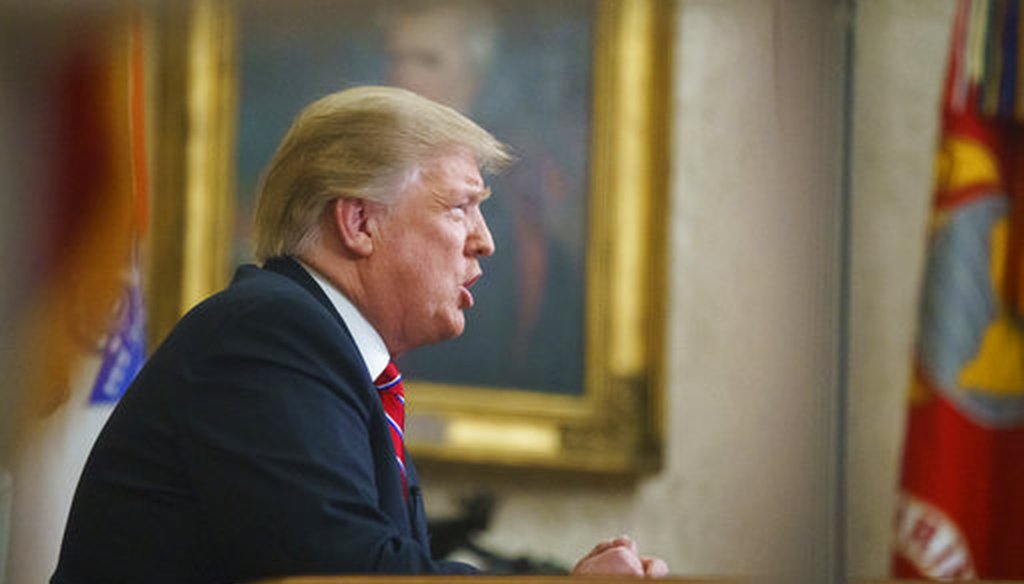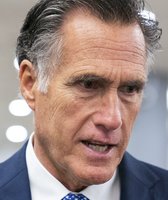Stand up for the facts!
Our only agenda is to publish the truth so you can be an informed participant in democracy.
We need your help.
I would like to contribute

As seen from a window outside the Oval Office, President Donald Trump gives a prime-time address about border security Tuesday, Jan. 8, 2018, at the White House in Washington. (AP Photo/Carolyn Kaster)
President Donald Trump is basing his latest push for border wall money on the premise that the United States is facing a humanitarian crisis and that a wall will solve it.
He used a prime-time televised address on Jan. 8 to rally public support for his position. Any deal to reopen the federal government needs to include $5.7 billion for wall funding, he said.
Yet, Trump’s address (we fact-checked it) and his description of a humanitarian crisis weren’t that different from claims he’s made before. He still painted immigrants as criminals and as a drain on the economy; he didn’t tell the full picture of how illicit drugs get into the United States; and he distorted the Democrats’ record on border security.
Trump’s address did not get at the heart of what immigration policy experts say is the actual crisis: the U.S. asylum system.
Thousands of desperate people are coming to the United States to escape violence and poverty in Guatemala, Honduras and El Salvador.
"The thing about the wall is that it's a visible symbol," said Randy Capps, director of research for U.S. programs at the nonpartisan Migration Policy Institute. "It’s easy to simplify around the wall and say a wall represents security."
But the interworking of the courts and the asylum system is much more complicated, and a wall won’t address those real issues, he said.
The United States is not being overrun by people trying to evade Border Patrol. The majority of people showing up at the southern border are women and children who want to request asylum, under the legal immigration system.
They are generally seeking out border agents, Capps said.
Once immigrants are in the asylum process, it can take years for their cases to be decided. That lengthy waiting period is what creates the biggest incentive for people to come to the United States, knowing they’ll be able to stay for at least some period of time, Capps said.
"Our border is not overwhelmed, but our asylum system is," said Christopher Wilson, deputy director of the Mexico Institute at the Wilson Center. "The most pressing funding needs are therefore in the asylum system, and possibly in foreign aid for Central America, rather than a border wall."
Allowing U.S. Citizenship and Immigration Services officers to make more asylum decisions, instead of referring them to immigration courts, could be one way to alleviate a growing asylum case backlog.
By focusing on a wall as the be-all and end-all of border security, the United States is missing out on a more relevant policy discussion, said Theresa Cardinal Brown, director of immigration and cross-border policy at the Bipartisan Policy Center.
"I think there's definitely a policy conversation to be had about what additional security is needed at the border," Brown said. "But the administration has increased enforcement efforts rather than try to figure out how to adjust the asylum system, policies and practices, and border infrastructure."
Trump said his administration handed Congress a proposal to secure the border that, on top of a wall, included technology, agents, immigration judges and medical support. Wilson said Trump’s focus on that was important, as there is bipartisan support for much of that.
Still, Trump’s big picture argument was that without a border wall, crime and drug trafficking would increase. Trump didn’t offer statistics to show that the situation now is much worse than it’s ever been, Brown said.
That’s because it isn't.
The overall number of people apprehended at the southwest border is well below the 1.6 million recorded in fiscal year 2000. Southwest border apprehensions during Trump’s time in office have been below 400,000. (However, under Trump, there’s been an uptick in the number of families apprehended by Border Patrol.)
As Trump noted, Mexico has become an increasing supplier of heroin to the United States. But a wall won’t have a measurable impact on the amount coming in. The majority is smuggled in vehicles through legal ports of entry. Traffickers also use tunnels, boats, drones, and as Trump once said, catapults, to get illicit drugs into the United States.
Trump also noted a lack of detention space as immigrants are coming in, but detention is not relevant as it pertains to families coming in. That’s because under current policies, families and children cannot be detained for extended periods of time. (Most people coming in now are children and families).
Trump did not offer the Democrats anything new Tuesday night. And they are no closer to giving the president what he wants.
"The stalemate continues for the foreseeable future," Brown said.
Our Sources
PolitiFact, Live fact-checking President Donald Trump's immigration address, Jan. 8, 2019
Phone interview, Randy Capps, director of research for U.S. programs at the nonpartisan Migration Policy Institute, Jan. 9, 2019
Phone interview, Theresa Cardinal Brown, director of immigration and cross-border policy at the Bipartisan Policy Center, Jan. 9, 2019
Email interview, Christopher Wilson, deputy director of the Mexico Institute at the Wilson Center, Jan. 9, 2019




































